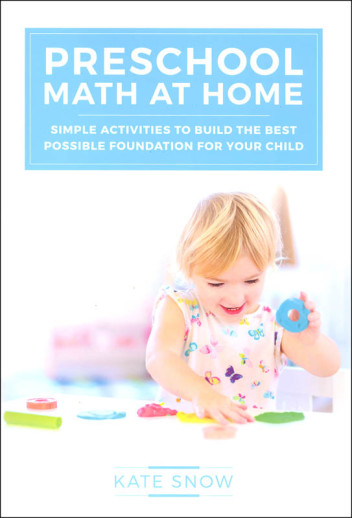We use cookies to make your experience better. To comply with the new e-Privacy directive, we need to ask for your consent to set the cookies. Learn more.
Preschool Math at Home
Math understanding doesn't magically occur when a child begins their academic years kindergarten and up. Their brains are developing from the time they are born, and you, the parent, can do things to help with that development and lay the foundation as they approach kindergarten. Games my favorite way to teach young children! This 100-page, softcover book is full of games to help your young child develop an understanding of number concepts counting, comparing and ordering, recognizing written numerals, and beginning addition and subtraction. You may already be doing some of the activities found in this book, but this book lays out the content in a categorized fashion. There are seven chapters counting to five, counting to ten, numbers from zero to five, numbers from six to ten, written numerals from 0 to 10, comparing quantities and numbers, and addition and subtraction stories. This isn't a workbook, but a great resource for parents.
Typically, you will be able to use these activities with a child who is about 4, but you know your child best and can begin when you believe they are ready. The author suggests that you do the activities in this book in the order they are presented, take as much time as needed with each, and a questionnaire at the end of each chapter will help you determine whether your child is ready to move on. Children may progress at different rates, so be patient as you work with your child. Most importantly, have fun while incorporating these activities into your child's day. You don't want them to hate math before they even get going strong. The activities use items from around your home or are easily accessible. You may want to put together a math basket with the following items: 20 small counters, resource pages from the back of the book, one nickel and ten pennies, blank paper and a writing tool. Additional items that may be used occasionally are: ten small toys, four stuffed animals, small blanket, two small paper bags, two regular dice, tape, two different small objects for game tokens, two different-coloring writing utensils, toy cups, plates, spoons, and play food items, dot stickers, small food items, large index cards, and small stickers.
Use these simple activities to solidify your child's math foundation and only spend a few minutes a day doing so. Get them ready for kindergarten math and have fun in the process. ~ Donna
Are you looking for a “Goldilocks” math curriculum? You know, the one that is not too hard, not too easy, but just right. Math with Confidence may pass the Goldilocks test for your child! Not only does it provide the right level of challenge for most children, but it also passes the Goldilocks test for parents with well defined goals, sequenced lessons, open and go scripted lessons, and easy to implement activities. The curriculum focuses on mastery with topical units and spiral review. Currently four levels are completed (K-3), with Grades 4 through 6 expected by 2026. The Instructor Guide and Student Workbook(s) are required to successfully teach the course.
Instructor Guides begin with introductory information and a helpful “how to use” section which gives parents the tools to confidently teach math. Scripted lessons for the teacher and easy to implement activities that use household items, along with a few common math manipulatives, the Instructor Guide equips parents to be successful. From Kindergarten through 2nd Grade, there are four teaching days and one optional enrichment or review day, for a total of 32 weeks. Weekly lessons have the same format: Overview of the week, lesson notes, and materials list for activities. Each lesson includes interactive teaching time and independent workbook time. The amount of time spent on each lesson will vary depending on the grade level. Kindergarten lessons will take about 15-20 minutes with First Grade requiring 20-25 minutes. Second Grade takes 20-30 minutes. Enrichment or review activities focus on games/activities or a suggested read aloud math book of the week. Beginning in Grade 3, the lessons have been grouped into units rather than weeks to provide more schedule flexibility. There are 16 units (128 regular lessons) in Grade 3, and each unit concludes with an optional enrichment activity and suggested picture book to read together. Lessons will take 25-35 minutes per day. Instructor Guides also include Answer Keys and Blackline master’s which are reproducible for your immediate family.
Colorful, consumable Student Workbooks provide independent daily work. In Grade 3, the Student Workbook is divided into 2 parts: Part A covering Units 1-8 and Part B Units 9-16. The Student Workbooks are reproducible for immediate family members, although the publisher has made great effort to keep the student workbooks affordable for families.
Manipulative Kits are available for your convenience.
| Product Format: | Paperback |
|---|---|
| Brand: | Well-Trained Mind Press |
| Author: | Kate Snow |
| Grade: | PK |
| ISBN: | 9781933339917 |
| Length in Inches: | 9.75 |
| Width in Inches: | 6.75 |
| Height in Inches: | 0.25 |
| Weight in Pounds: | 0.5 |

